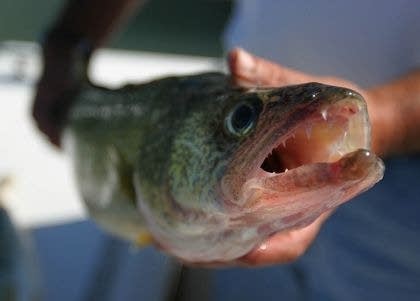Fish kills are not uncommon in Minnesota, but a new study paints a dire future for fish in northern lakes.
"We were mainly curious how many of these mass fish die offs might happen under future climate change," said Simon Tye, a Ph.D. candidate in the Department of Biological Sciences at the University of Arkansas and lead author of the study.
The study used a decade of documented fish kills across Minnesota and Wisconsin and more than one million water and air temperature profiles from 8,891 northern lakes.
It also used projections of future temperature increases as a result of climate change.
Assuming the current pace of climate change does not slow, the computer models predict a 600 percent increase in fish kills by 2100.
"It's pretty drastic, it's pretty startling. And it's worrisome for the future of fish across those lakes," said Tye.
A scary future
“I was surprised by the scale of the impact,” said University of Minnesota Assistant Professor Nick Phelps who helped compile the fish kill database. “It’s a scary future if that’s the way it plays out.”
"Right now we estimate that there are about 500 fish kills a year here in Minnesota,” explained Phelps. “The conservative estimates from this research suggests that by the end of the century, there will be several thousand fish kills that happen each year."

Pelican Rapids student Parker Sanchez casts his line as his father Fred pilots the boat during the Heart O'Lakes High School Fishing League event June 13, on Big Cormorant Lake in western Minnesota.
David L. Wallis for MPR News | 2019
The change will be gradual over decades with a significant increase noted in the next 30 years.
While temperatures are projected to steadily increase, Phelps said there will likely also be more extreme weather events, with heat waves that quickly raise water temperatures and cause fish mortality.
The study also predicts there will be fewer fish kills during the winter. Winter fish kills often happen when lakes are covered by heavy snow which blocks sunlight, reducing the oxygen produced by aquatic plants. Tye said future climate predictions are for less snow and ice on Minnesota lakes, which is expected to reduce the winter fish mortality.
The primary causes of fish kills in the Upper Midwest are infectious disease and low oxygen levels in water according to the researchers. Warming water exacerbates both of those risks.
Warmer water holds less oxygen, and warmer water stresses fish making them more susceptible to disease.
Recorded fish kills document large numbers of adult fish that die in a short period and typically wash ashore. But there are ripple effects on complex lake ecosystems which are not well understood, said Tye.
"There are many detrimental effects on the juveniles and embryos and eggs, which we're not going to register in our datasets, because nobody's out there recording that," he said.
A threat to cold and warm water species
Warming water is a well documented threat to cold water fish species like salmon, trout or cisco.
But the researchers say there is also a significant threat to warm water fish species.
"Most of the documented deaths were of bluegill and sunfish, major game fish in the region,” said Tye. “And those deaths were primarily attributed to lower dissolved oxygen concentration."
As fish kills happen more often, it will become more difficult for fish populations in a lake to recover, said Phelps. If this prediction is borne out through the rest of this century, Minnesota fisheries will be significantly changed.
"There's going to be a shift from a walleye, perch dominated system to a bass, bluegill dominated system as the water warms, and that's because of the impact on the production and food availability and everything else,” he said. “The way we'll see that change happen over time is likely through mortality events, fish kills."
The researchers believe these effects could be mitigated somewhat if temperatures don't rise as much as predicted. And there may be management techniques to keep bodies of water healthy as the water warms.
“We know that healthy ecosystems are more resilient,” said Phelps. “And so things that can keep our lakes healthy, like reducing shoreline development, preventing the introduction of invasive species, reducing chemical runoff, those are all good things for the lake.”
But a changing climate might also mean managing for a new normal where fish populations are different, or much smaller. Tye suggests such a substantial increase in fish mortality events will be difficult to manage.

Walleye is one of the species likely to be impacted by climate change.
Tom Robertson | MPR
"It will probably stretch the resources of the Department of Natural Resources, because if there are thousands of lakes that are increasing in temperature, there's only so many that we can devote our time to rehabilitate,” he said. “So it simply could become too much of a mess for us to theoretically clean up."
Based on the computer models run for this project, Tye believes the projections in this study are conservative, not a worst case scenario.
"fish" - Google News
September 20, 2022 at 04:00PM
https://ift.tt/8e6tPqI
A warming climate brings dire predictions for Minnesota fish - MPR News
"fish" - Google News
https://ift.tt/L2FompZ
https://ift.tt/Vhyi2o5
Bagikan Berita Ini














0 Response to "A warming climate brings dire predictions for Minnesota fish - MPR News"
Post a Comment